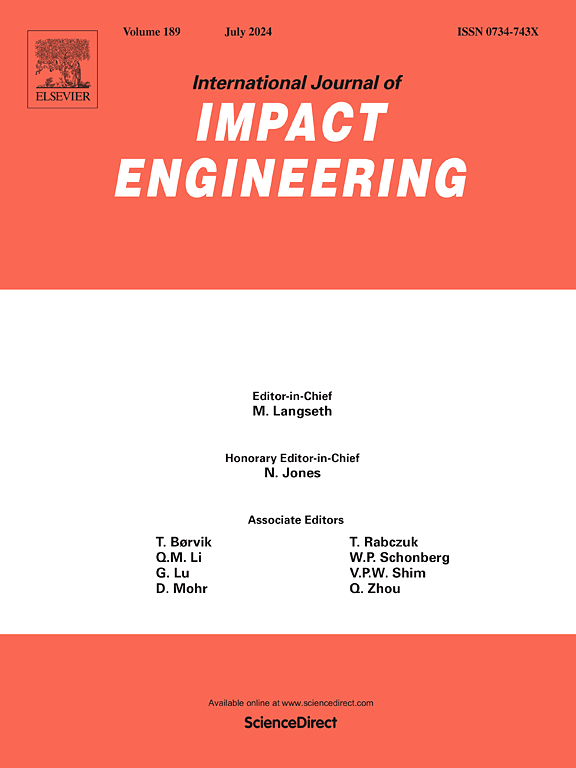影响爆炸螺栓分离特性的因素研究
IF 5.1
2区 工程技术
Q1 ENGINEERING, MECHANICAL
International Journal of Impact Engineering
Pub Date : 2025-03-19
DOI:10.1016/j.ijimpeng.2025.105320
引用次数: 0
摘要
弱凹槽爆炸螺栓结构简单,承载能力高,在航空航天、导弹分离等领域得到了广泛的应用。然而,这些螺栓的微秒级分离时间对捕获整个分离过程提出了重大挑战。为阐明爆炸螺栓的破坏模式,了解影响爆炸螺栓分离特性的因素,分别进行了装药量、弱化槽位置和外部约束条件对爆炸螺栓分离特性的影响实验研究。通过分析分离过程中材料应力和硐室压力的变化,确定了爆炸锚杆分离所需的临界装药量,了解了爆炸锚杆破坏模式与应力集中区面积的相互作用机制。结果表明:当装药量增加到一定值时,爆炸螺栓发生拉剪复合断裂;在锚杆表面形成弱化槽,可以有效地限制爆炸锚杆的破坏区域。爆炸锚杆分离截面上的应力集中区与弱化槽段之间存在高度重叠。减弱槽右端与装药室底部距离的变化对分离截面状态有显著影响。在此基础上,对有和无外部约束条件的五种实验类型的分离特性进行了比较分析。值得注意的是,在约束条件下,每种螺栓的头部结构都通过爆炸焊接与上部连接件熔断。通过对影响区域的比较,阐明了产生这种现象的原因。研究结果为弱槽爆破螺栓结构优化设计提供了依据。本文章由计算机程序翻译,如有差异,请以英文原文为准。

Study on the factors influencing the separation characteristics of explosive bolts
Explosive bolts with weakening grooves are widely employed in aerospace, missile separation, and other fields due to their simple structure and high load-bearing capacity. However, the microsecond-level separation time of these bolts poses significant challenges in capturing the entire separation process. To elucidate the failure modes of explosive bolts and understand the factors influencing their separation characteristics, experimental studies were conducted respectively to investigate the effects of charge weight, the location of weakening grooves, and externally constrained conditions on the separation characteristics of explosive bolts. This study determined the critical charge weights required for explosive bolt separation, and the mechanism of interaction between the failure modes of explosive bolts and the area of stress concentration regions was understood by analyzing the variations in material stress and chamber pressure during the separation process. The findings show that the explosive bolt undergoes a tensile-shear composite fracture when the charge weight increases to a certain value. The creation of weakening grooves on the bolt surface can effectively confine the damaged area of the explosive bolts. A high degree of overlap was observed between the stress concentration areas on the separation cross-section of the explosive bolt and the weakening groove segment. Furthermore, the variations in the distance between the right end of the weakening groove and the bottom of the charge chamber significantly affect the separation cross-section state. Building on these findings, a comparative analysis of the separation characteristics of five experimental types with and without externally constrained conditions was conducted. Notably, under constrained conditions, the head structure of each type of bolt fuses with the upper connecting pieces through explosive welding. By comparing the impact area, the reasons for this phenomenon are elucidated. The research results provide a foundation for optimizing the structural design of weakening groove explosive bolts.
求助全文
通过发布文献求助,成功后即可免费获取论文全文。
去求助
来源期刊

International Journal of Impact Engineering
工程技术-工程:机械
CiteScore
8.70
自引率
13.70%
发文量
241
审稿时长
52 days
期刊介绍:
The International Journal of Impact Engineering, established in 1983 publishes original research findings related to the response of structures, components and materials subjected to impact, blast and high-rate loading. Areas relevant to the journal encompass the following general topics and those associated with them:
-Behaviour and failure of structures and materials under impact and blast loading
-Systems for protection and absorption of impact and blast loading
-Terminal ballistics
-Dynamic behaviour and failure of materials including plasticity and fracture
-Stress waves
-Structural crashworthiness
-High-rate mechanical and forming processes
-Impact, blast and high-rate loading/measurement techniques and their applications
 求助内容:
求助内容: 应助结果提醒方式:
应助结果提醒方式:


